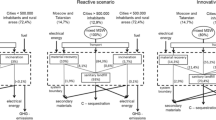Abstract
In order to determine the optimal final destination of municipal solid waste, it is necessary to consider both monetary costs and environmental externalities, such as carbon balance and GHG production, as well as the local availability of waste-processing industrial infrastructure. In order to develop a strategy for the selection of the optimal waste management system, in the present work we consider a specific city located in Piedmont (northern Italy). The volume of municipal solid waste produced in the city is about 540,000 ton/year. To determine the best method for management and disposal of this volume, we considered three different scenarios, using the best available technologies. The scenarios included the use of both thermal processing systems (incineration and gasification plants) and other systems (mechanical separation plants, anaerobic digestion plants). The scenarios were analyzed and compared, considering environmental, construction and operating costs, in order to develop a model for making an objective comparison. The results of the analysis for this specific case revealed that direct combustion in an incineration plant delivered the best outcome for both environmental impacts and economic convenience. More generally, the comparison methodology for the scenarios can be a useful approach for determining the best solution for waste management planning for a specific locality.
Similar content being viewed by others
References
Wittmaier, M., Langer, S., Sawilla, B.: Possibilities and limitations of life cycle assessment (LCA) in the development of waste utilization systems—applied examples for a region in Northern Germany. Waste Manage. 29, 1732–1738 (2009)
Cherubini, F., Bargigli, S., Ulgiati, S.: Life cycle assessment (LCA) of waste management strategies: landfilling, sorting plant and incineration. Energy 34, 2116–2123 (2009)
ISPRA (Istituto Superiore per la Protezione e la Ricerca Ambientale), Rapporto Rifiuti.: http://www.apat.gov.it/site/it-IT/APAT/Pubblicazioni/Rapporto_rifiuti/Documento/rapporto_rfi08.html#Sommario (2008). Accessed 18 March 2011;
Read, A.D., Phillips, P., Robinson, G.: Landfill as a future waste management option in England: the view of landfill operators. Resour. Conserv. Recycl. 20, 183–205 (1997)
Statistics Norway.: http://www.ssb.no/avfhand_en/. Accessed 8 March 2012
IPPC (Integrated Pollution Prevention and Control), European Commision, Reference Document on the Best Available Techniques for Waste Incineration, August 2006
Powell, J.C.: The evaluation of waste management options. Waste Manage. Res. 14, 515–526 (1996)
Huhtala, A.: How much do money, inconvenience and pollutant matter? Analysis household demand for large—scale recycling and incineration. J. Environ. Manage. 55, 27–38 (1999)
Mirandce, M.L., Hale, B.: Waste not, want not: the private and social costs of waste-to-energy production. Energy Policy 25, 587–600 (1997)
Dijkgraaf, E., Vollerberg, H.R.J.: Burn or bury? A social cost comparison of final waste disposal methods. Ecol. Econ. 50, 233–247 (2004)
Industrial Cost Engineering (ICE).: http://www.costestimating.com/. Accessed 23 March 2011
European Commission, 2003.: External costs—research results on socio—environmental damages due to electricity and transport, EUR 20198
Eshet, T., Ayalon, O., Shechter, M.: Valuation of externalities of selected waste management alternatives: A comparative review and analysis. Resour. Conserv. Recycl. 46, 335–364 (2006)
Rabl, A., Spadaro, J.V., Mc Gavran, P.D.: Health risk of air pollution from incineration: a perspective. Waste Manage. Res. 16, 365–388 (1998)
Rabl, A., Spadano, J.V.: Health Impacts of waste incineration, issues in environmental science and technology, vol. 18, environmental impact of solid waste management activities, pp. 171–193. Royal Society of Chemistry, UK (2002)
Fichtner Consulting Engineers Ltd.: The viability of advanced thermal treatment of MSW in the UK, for ESTET (2004)
Arena, U., Zaccariello, L., Mastellone, M.L.: Fluidized bed gassification of waste-derived fuels. Waste Manage. 30, 1212–1219 (2010)
Belgiorno, V.: Energy from gasification of solid wastes. Waste Manage. 23, 1–15 (2003)
Malkow, T.: Novel and innovative pyrolysis and gasification technologies for energy efficient and environmentally sound MSW disposal. Waste Manage. 24, 57–79 (2004)
European Commission edited by Bickel Peter and Friedrich Rainer.: ExternE—externalities of energy methodology 2005 update, Institut für Energiewirtschaft und Rationelle Energieanwendung—IER Universität Stuttgart—Germany, ISBN: 92-79-00423-9 (2005)
Genon, G., Brizio, E.: Perspectives and limits for cement kilns as a destination for RDF. Waste Manage. 28, 2375–2385 (2008)
Barton, J.R., Poll, A.J., Webb, M., Whalley, L.: Waste sorting and RDF—production in Europe. Elsevier, London (1985)
ATO-R.: Verifica della fattibilità di un impianto di trattamento termico dei rifiuti a tecnologia innovativa nella provincia di Torino, Ingegneria Ambientale, Quaderni, 51, p 79 (2010)
TRM (Trattamento Rifiuti Metropolitani).: Impianto di termovalorizzazione dei rifiuti della provincia di Torino—Italia, Bilanci termici e di massa (2006)
Canovai A., Consorzio Italiano Compostatori.: La proposta operativa: modello tecnico-economico impiego sistema UMICA, workshop, Salerno (2009).18 March 2009
GME—Gestore Mercati Energetici.: http://www.mercatoelettrico.org/It/Default.aspx. Accessed 12 July 2010
De Baere, L., Boelens, J. (OWS).: Rest or mixed waste sorting—digestion—separation for the recovery of recyclables and energy. http://www.ows.be. Accessed 12 July 2010
Blengini, G.A., Genon, G.: LCA del sistema integrato dei RSU nella Provincia di Torino—Analisi energetico ambientale con metodologia LCA ed analisi economica dell’attuazione del Piano Provinciale di Gestione dei Rifiuti alla luce dei nuovi obiettivi di Raccolta Differenziata introdotti dal D.Lgs. 152/06”, Provincia di Torino, p 50 (2008)
Boldrin, A., Andersen, J.K., Møller, J., Christensen, T.H., Favoino, E.: Composting and compost utilization accounting of greenhouse gases and global warming contributions. Waste Manage. Res. 27, 800–812 (2009)
Møller, J., Boldrin, A., Christensen, T.H.: Anaerobic digestion and digestate use: accounting of greenhouse gases and global warming contribution. Waste Manage. Res. 27, 813–824 (2009)
Lgs, D.: 29 aprile 2006, n. 217, Revisione della disciplina in material di fertilizzanti, published into Gazzetta Ufficiale n. 141 of 20 June 2006, SO n. 152
Author information
Authors and Affiliations
Corresponding author
Rights and permissions
About this article
Cite this article
Panepinto, D., Genon, G. Carbon Dioxide Balance and Cost Analysis for Different Solid Waste Management Scenarios. Waste Biomass Valor 3, 249–257 (2012). https://doi.org/10.1007/s12649-012-9120-z
Received:
Accepted:
Published:
Issue Date:
DOI: https://doi.org/10.1007/s12649-012-9120-z




